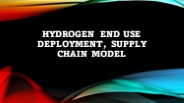Hydrogen Supply PowerPoint PPT Presentations
All Time
Recommended
hydrogen supply chain Understanding the Surge in Hydrogen Demand: Definition of Hydrogen as an Energy Carrier: Hydrogen, in the context of energy, serves as an energy carrier rather than a primary source of energy. It is a versatile and clean energy carrier that can store, transport, and deliver energy in various forms.
| PowerPoint PPT presentation | free to download
The process of planning and overseeing the many tasks involved in the production, distribution, storage, and transportation of hydrogen in the most economical and efficient manner is known as Hydrogen Supply Chain optimization. Optimization is the process of locating and fixing inefficiencies, bottlenecks, and other obstacles that can prevent hydrogen from moving freely throughout the supply chain.
| PowerPoint PPT presentation | free to download
The process of planning and overseeing the many tasks involved in the production, distribution, storage, and transportation of hydrogen in the most economical and efficient manner is known as hydrogen supply chain optimization. Optimization is the process of locating and fixing inefficiencies, bottlenecks, and other obstacles that can prevent hydrogen from moving freely throughout the supply chain.
| PowerPoint PPT presentation | free to download
The deployment of hydrogen in end-use applications is expected to involve a combination of on-site clusters, co-production, and dedicated supply chain models. The specific approach will depend on factors such as the scale of hydrogen demand, industry requirements, infrastructure availability, and regional considerations.
| PowerPoint PPT presentation | free to download
Hydrogen Peroxide Suppliers in Uae, Hydrogen Peroxide in Dubai, Laboratory Scientific Supplies, Scientific Laboratory Supplies, Chemical Laboratory Supplies, Laboratory Supplies Company. Visit @ https://chemstock.ae/hydrogen-peroxide-suppliers-in-dubai/
| PowerPoint PPT presentation | free to download
Harnessing Hydrogen for Power: Hydrogen Cars Marisa Katz Hannah Lobingier What exactly is a Hydrogen Car In a hydrogen car, its primary source of power is from ...
| PowerPoint PPT presentation | free to download
The global hydrogen powered transport market size is expected to grow from $3.27 billion in 2021 to $5.15 billion in 2022 at a compound annual growth rate (CAGR) of 57.5%.
| PowerPoint PPT presentation | free to download
Hydrogen Fuel Cell Gas Diffusion Layer market is segmented by region, by country, company, type, application and by sales channels.
| PowerPoint PPT presentation | free to download
Hydrogen does not exist in nature by itself, but it is found as part of a ... cells can supply energy to power anything from automobiles to homes to computers. ...
| PowerPoint PPT presentation | free to view
INTERNATIONAL CONFERENCE ON HYDROGEN SAFETY Second Plenary Risk Management Approaches to Hydrogen Safety, Regulations, Codes, and Standards (RCS)
| PowerPoint PPT presentation | free to download
Hydrogen Institute: Overview of hydrogen research at the Institute. Dr. Tapan K. Bose ... H2 Storage activities at the Hydrogen Research Institute ... Spectrogram ...
| PowerPoint PPT presentation | free to view
Sustainable energy supply; Is Hydrogen an option? Myths and facts C. Daey Ouwens Eindhoven University of Technology Outline Some considerations about sustainability ...
| PowerPoint PPT presentation | free to view
Trailer. Compressor. Accumulator. Dispenser. On-site type. Off-site type. FCV. Overview ... No damage to nearby houses. Minor Damage. 5. Windows broken. Small ...
| PowerPoint PPT presentation | free to view
Material Test (Stainless steels, Chromium Molybdenum steels ) Reliability of compressor ... (Stainless Steels and Chromium Molybdenum Steels) Tests for Hydrogen ...
| PowerPoint PPT presentation | free to view
... and electric vehicles provide large improvements in the efficient use of car fuel. ... 'Near Zero' CO2 emissions are achieved with hydrogen & electric cars. ...
| PowerPoint PPT presentation | free to view
Estimating the Cost of a Low Carbon Hydrogen Supply in the ... Carol Shay and Dan Loughlin at EPA for the use of their model and their help in using the model ...
| PowerPoint PPT presentation | free to view
Educate key audiences about hydrogen and fuel cell technologies to facilitate ... A 'Cliff's Notes' poster with critical course summary information is also ...
| PowerPoint PPT presentation | free to view
CYANIDE AND HYDROGEN SULFIDE Perspective Hydrogen cyanide (prussic acid) is a gas with many commercial uses, particularly in synthetic fiber manufacture and fumigation.
| PowerPoint PPT presentation | free to download
Andre W. Van Rest. MISSION. The Mid-Atlantic Hydrogen Coalition (MAHC) ... Promote alternative fuels as a stepping stone to the hydrogen economy. Objectives ...
| PowerPoint PPT presentation | free to view
Hydrogen Storage and Transportation Technologies - Cost and Supply Chain Analysis. Current and evolving hydrogen storage and transportation technologies aim to address the challenges of storing and transporting hydrogen efficiently and safely.
| PowerPoint PPT presentation | free to download
Emerging Techno-Commercially attractive Hydrogen Business Models - Hydrogen Generation, Hydrogen Storage, and Hydrogen Distribution. Hydrogen Generation: • Steam Methane Reforming (SMR): Steam Methane Reforming (SMR): SMR is currently the most common method for large-scale hydrogen production, accounting for the majority of global hydrogen supply. It involves reacting natural gas (methane) with steam to produce hydrogen and carbon dioxide. SMR is a mature technology and has well-established infrastructure. However, it is associated with greenhouse gas emissions unless carbon capture and storage (CCS) technologies are employed
| PowerPoint PPT presentation | free to download
Green hydrogen (GH) scaling faces several key problems that must be addressed before mainstream usage. Technology readiness and cost, infrastructure development, market off-takers, funding, supply chain constraints, and policy frameworks are among the challenges.
| PowerPoint PPT presentation | free to download
Hydrogen Energy Storage Market
| PowerPoint PPT presentation | free to download
H2S SAFETY TRAINING (HYDROGEN SULFIDE) INSTRUCTOR: Rolando S. Bulatao Jr. H2S SAFETY TRAINING What is Hydrogen Sulfide (H2S)? Where do you find H2S?
| PowerPoint PPT presentation | free to download
Hydrogen An Alternative Fuel For Automobiles By: K. Dzwonkowski From H To Fuel 2 The Need for Alternative Fuels -Current Supply of Fossil Fuels may be exhausted by ...
| PowerPoint PPT presentation | free to view
Hydrogen Fuel Cell Market By Type (Proton Exchange Membrane Fuel cells, Phosphoric Acid Fuel Cells, Solid Oxide Fuel Cells, Molten Carbonate Fuel Cells, Others), By Application (Stationary, Transportation, Portable), By End User (Fuel Cell Vehicles, Utilities, Defense) and region (North America, Europe, Asia-Pacific, Middle East and Africa and South America)
| PowerPoint PPT presentation | free to download
Leveraging Hydrogen Technologies for a Sustainable Future: Hydrogen, often hailed as the "fuel of the future," is making significant strides in the energy sector. As the world seeks more sustainable and environmentally friendly energy solutions, hydrogen has emerged as a key player in the transition to a cleaner and greener future. This article explores the various facets of hydrogen technologies, from production and storage to its applications in power generation, transportation, and industry. We'll also delve into the winning imperatives for businesses and technology companies looking to gain a competitive edge in the rapidly evolving hydrogen landscape.
| PowerPoint PPT presentation | free to download
TOP 10 HYDROGEN PRODUCTION COST OPTIMIZATION TECHNIQUES Hydrogen production cost analysis is crucial for understanding the economic viability of hydrogen as an energy source. But do you know what are those Cost Optimization techniques, how to identify, which phase to implement?
| PowerPoint PPT presentation | free to download
The term "Hydrogen Market Penetration" describes how widely hydrogen is accepted and utilized as a feedstock or energy source across a range of sectors and applications. The potential use of hydrogen as a clean energy carrier has drawn a lot of attention. It has the potential to significantly lower greenhouse gas emissions, especially in industries like heavy manufacturing and transportation that are difficult to decarbonize. Read More - https://www.marketsandmarkets.com/industry-practice/hydrogen/market-penetration
| PowerPoint PPT presentation | free to download
Strategies for integrating hydrogen as a resource and energy carrier into many economic sectors, including transportation, manufacturing, and power generation, are known as Hydrogen Integration Strategies. Reducing greenhouse gas emissions and moving toward a more sustainable energy system are thought to be possible with the help of hydrogen.
| PowerPoint PPT presentation | free to download
Hydrogen integration strategies refer to plans and approaches for incorporating hydrogen as an energy carrier and resource into various sectors of the economy, such as industry, transportation, and power generation. Hydrogen is seen as a promising solution for reducing greenhouse gas emissions and transitioning to a more sustainable energy system.
| PowerPoint PPT presentation | free to download
The hydrogen industry has seen significant expansion and investment in recent years due to the increased interest in hydrogen as a flexible and sustainable energy source. The reduction of carbon footprints is being supported across a wide range of industries, including electricity generation, transportation, and business. Hydrogen is one such industry. Read More - https://www.marketsandmarkets.com/industry-practice/hydrogen/hydrogen-industry-investments
| PowerPoint PPT presentation | free to download
Green hydrogen is a nontoxic, carbon-friendly gas produced by the splitting of water molecules into hydrogen gas through electrolysis, releasing oxygen as a byproduct. The process involves the passage of electric current through an electrolyzer. Green hydrogen is considered carbon-free; therefore, even the electricity utilized for electrolysis should be generated through renewable sources. Several global researchers & scientists concur that green hydrogen can emerge as a befitting solution to mitigate the burgeoning problem of global warming and help achieve a green gas-neutral economy by 2050. Click here to get better acquainted with our pivotal services. https://www.iebrain.com/events/carbon-capture-technology-expo-europe-and-hydrogen-technology-expo-europe/#meetus
| PowerPoint PPT presentation | free to download
hydrogen unit 9 prepared by prashanth c p kv ganeshkhind pune.
| PowerPoint PPT presentation | free to view
The hydrogen ecosystem is a rapidly evolving sector with many players involved in various aspects of the hydrogen value chain, including hydrogen production, storage, transportation, and utilization.
| PowerPoint PPT presentation | free to download
The US market for Hydrogen Peroxide have showcased increase in prices throughout the first quarter of 2022 as the cleaning practices from end consumers improved which increased the demand for Hydrogen Peroxide as a cleaning agent. Prices during Q1 of 2022 were recorded around USD 678/MT. Prices of upstream crude oil as its supply remained disrupted globally on account of the conflict between Russia and Ukraine. As there was no improvement in the supply and imports of Hydrogen Peroxide, the traders in the American market began offering premiums in Hydrogen Peroxide offers during the first quarter of 2022.
| PowerPoint PPT presentation | free to download
Hydrogen Subsonic Upward Release and Dispersion Experiments in Closed Cylindrical Vessel Denisenko V.P.1, Kirillov I.A.1, Korobtsev S.V.1, Nikolaev I.I.1,
| PowerPoint PPT presentation | free to download
Hydrogen Integration Strategies are methods for incorporating hydrogen as a resource and energy carrier into a variety of economic sectors, such as manufacturing, transportation, and power production. It's believed that hydrogen can help reduce greenhouse gas emissions and transition to a more sustainable energy system. Read More - https://www.marketsandmarkets.com/industry-practice/hydrogen/integration-strategies
| PowerPoint PPT presentation | free to download
The production, storage, delivery, and use of hydrogen are only a few of the numerous companies that are involved in the fast developing hydrogen ecosystem. Strategic analysis and stakeholder and player collaboration are key components of the hydrogen ecosystem. Read More - https://www.marketsandmarkets.com/industry-practice/hydrogen/hydrogen-ecosystem-players
| PowerPoint PPT presentation | free to download
A cost analysis of hydrogen production is a crucial step towards determining the viability and sustainability of hydrogen as a clean energy source. A detailed examination of the expenses associated with producing hydrogen is necessary in order to encourage advancements in this field. We can identify opportunities for cost optimization by examining several production methods, such as electrolysis or steam methane reforming, and calculating the expenses related to each stage. Read More - https://www.marketsandmarkets.com/industry-practice/hydrogen/hydrogen-production-cost-analysis
| PowerPoint PPT presentation | free to download
When hydrogen is used in a fuel cell to create power it is ... liquid hydrogen since the 1970s to propel the space shuttle and other rockets into orbit. ...
| PowerPoint PPT presentation | free to view
Current and evolving hydrogen storage and transportation technologies aim to address the challenges of storing and transporting hydrogen efficiently and safely.
| PowerPoint PPT presentation | free to download
Key Challenges for Hydrogen Technologies in The Future Hydrogen technologies have great potential, but before they can be successfully implemented and widely used in the future, a number of important issues must be resolved: Cost Competitiveness: Compared to traditional fossil fuel-based alternatives, the cost of producing hydrogen, especially green hydrogen from renewable sources, is now greater. Hydrogen production, storage, and infrastructure development come with significant capital and operating expenses, which makes it difficult for hydrogen technologies to become widely used. Infrastructure Development: A strong hydrogen infrastructure must be established before hydrogen technologies may be widely used. The construction of pipelines or other alternate distribution systems, refueling stations, storage facilities, and hydrogen generating facilities are all included in this.
| PowerPoint PPT presentation | free to download
Hydrogen has gained significant attention as a versatile and clean energy carrier, and developing countries are capitalizing on its potential due to several factors, including rapid industrialization, increasing energy demand, and abundant renewable energy resources.
| PowerPoint PPT presentation | free to download
The Hydrogen Economy would be a transition from using fossil ... Global Warming. Increasing Costs. Limited Supply. How will Hydrogen Help? ... Hydrogen Facts ...
| PowerPoint PPT presentation | free to view
An essential component in assessing the sustainability and practicality of hydrogen as a clean energy source is the analysis of the costs associated with producing hydrogen. To propel progress in this area, a thorough analysis of the cost of producing hydrogen must be carried out. We can find areas for cost improvement by looking at several manufacturing techniques, like steam methane reforming or electrolysis, and evaluating the costs associated with each stage.
| PowerPoint PPT presentation | free to download
Hydrogen fuel cell recycling market is a rapid adoption of hydrogen fuel cells across various industries shows the critical need for optimal recycling solutions
| PowerPoint PPT presentation | free to download
The growing demand for less oil and diesel dependence and the increasing concern about emission control is driving the demand for the market.
| PowerPoint PPT presentation | free to download
Renewable Hydrogen
| PowerPoint PPT presentation | free to download
Hydrogen Storage Challenges and Solutions An essential element of the hydrogen economy is Hydrogen Storage. Hydrogen needs to be stored at high pressure, low temperature, or in a solid-state material because of its low density and strong flammability. The ability to store and transfer hydrogen gas for use in a variety of applications, such as industrial operations, power generation, and transportation, makes hydrogen storage an essential part of the hydrogen energy ecosystem. Read More -https://www.marketsandmarkets.com/industry-practice/hydrogen/hydrogen-storage-solution
| PowerPoint PPT presentation | free to download
A Hydrogen Economy Agenda A Hydrogen Vision of the Future Hydrogen Systems Producing Hydrogen Storing and Transporting Hydrogen Hydrogen Fueled Transport Problems ...
| PowerPoint PPT presentation | free to view
Incorporating hydrogen into the broader objective of achieving net zero emissions goals can be done through several key strategies and applications. Here are some ways to incorporate hydrogen
| PowerPoint PPT presentation | free to download
The growing interest in hydrogen as a flexible and sustainable energy source has led to a major expansion and investment in the hydrogen sector in recent years. Many businesses, including business, transportation, and the production of power, are supporting the reduction of carbon footprints. Among these is the Hydrogen Industry. Read More - https://www.marketsandmarkets.com/industry-practice/hydrogen/hydrogen-industry-investments
| PowerPoint PPT presentation | free to download
One element of the hydrogen economy that is essential is hydrogen storage. Hydrogen has to be stored at low temperatures or in a solid state due to its great flammability and low density. Read More - https://www.marketsandmarkets.com/industry-practice/hydrogen/hydrogen-storage-solution
| PowerPoint PPT presentation | free to download
Renewable Hydrogen
| PowerPoint PPT presentation | free to view
Small-Scale Wind for Hydrogen Production for Rural Power Supplies: ... Zebedee furl ( cone) system. allows for dynamic balance. between the rpm and the pitch ...
| PowerPoint PPT presentation | free to view
























































